at the Sign of the Hygra
2 Middleton Road
London E8 4BL
Tel: 00 44 (0)20 7254 7074
email: boxes@hygra.com
Antique Boxes in English Society
1760 -1900
by ANTIGONE
WRITING BOXES
| ANTIQUE BOXES at the Sign of the Hygra 2 Middleton Road London E8 4BL Tel: 00 44 (0)20 7254 7074 email: boxes@hygra.com |
Antique Boxes in English Society |
 Thumbnail index.
Thumbnail index. |
News | Buying Boxes | Contact us | The Schiffer Book | Advanced Search | Request current list of available writing boxes.
BEFORE 1780 |FROM 1780-1800 | FROM 1800-1830 | FROM 1830-1900
|
"a lady's traveling box" from Thomas Sheraton
|
Request current list of available writing boxes.
WRITING BOXES and SLOPES 1780-1800
|
|
|
Well to do young men found a way of accumulating knowledge by going on the 'grand tour' of Europe. Some came back wiser, some just had a good time. Architects, artists, thinkers took to traveling more seriously and brought back impressions, drawings, objects and sculptures. Their knowledge was disseminated through publications and through professional application. Men with entrepreneurial leanings went off to India, China and wherever there were trading opportunities, traveling on English ships which were establishing their supremacy on the oceans. The mobility of a substantial section of the population became part of the social ethos. |
 |
Detail showing the hand cut dovetails and the handle. Note the early type of screws used for fixing the brass. this is a typical Georgian writing box in mahogany with brass corners and side handles circa 1790. The drop handles point to an early date. |
|
|
Request current list of available writing boxes.
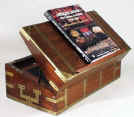
|
A brass bound mahogany Captains
writing box with secret compartments and drawers circa 1800.
The Schiffer book for collectors Antique Boxes, Tea Caddies and Society 1700-1880. by Antigone Clarke and Joseph O'Kelly is now in print and can be ordered from the links www.hygra.com/book Read what people are saying about it. |
EXCEPTIONAL WRITING BOXES
|
These are stylistically the same as the writing boxes described above, but they are made to perform an extra service for their owner. 1. One type of such writing box incorporates personal grooming items such as a gentleman would require on his travels, i.e. shaving and general hygiene containers. 2. Another type incorporates a machine for printing. This comprises a heavy brass cylinder, which is turned by a handle over a sliding surface, enabling the fast copying of maps, dispatches etc. 3. Ship Captain's Writing Box. Mechanically the most complex and intriguing of all such boxes. Each one seems to differ in its arrangement of secret compartments and drawers. Often there are spaces for candlesticks and a reading stand. Their most unique feature is that they have a mechanism enabling them to be screwed down, thus achieving some stability in stormy seas. 4. Triple opening writing boxes. These were made to open in two directions, one part upwards, the other down. The middle and down part form the two sections of the normal writing box. The upper part opens as an upright lid with an attached leather covered container and sometimes 'pockets' for notes etc. Most impressive even when opened to writing position. These four types of writing box are now rare. |
|
| Opulent high Regency writing box veneered in very
thick strongly figured kingwood, banded and inlaid with brass,
having brass set-in handles to the sides. English circa
1815. |
| Large military style brass bound solid mahogany writing box of dovetail construction with countersunk brass handles a side document drawer and secret drawers beneath the pen tray concealed behind a sprung panel. The box retains its original green baize writing surface. Beneath the surface there are compartments for keeping papers. Unusually there is a tooled leather document wallet, Circa 1810. |
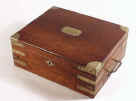 |
|
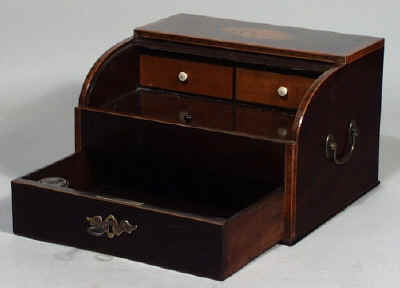 |
A Rare late 18th Century Mahogany, Tambour Top Writing Box Circa 1800 |
WRITING SLOPES LATE 18th CENTURY.
|
These are not as usual as the rectangular boxes, but the ones, which have
survived to our day, bear witness of fine artistic judgment and craftsman-ship.
They were made for gentler more personal use and as such they are more varied
in style than the 'military' writing boxes.
The postal service was pretty inefficient and chaotic up to about 1784, when armed guards were introduced on mail coaches rendering them safe, fast and efficient for the first time. Delivery of letters was much improved and so was the art of letter writing, which became a genteel occupation in its own right. Fine boxes, which could easily be carried from room to room and fit comfortably within the interiors of fine drawing rooms and libraries, were made to serve the need of private correspondence. These boxes are smaller and of a more delicate style than the solid mahogany brass bound type. They are a development of the early sloping bible box shape, only the slope is more gentle, the box shallower and the construction much lighter. The front cover of the box opens back to reveal a sloping surface for writing. This consists of a flap, under which there is a space for paper. At the back there is a section for inkwells and pens. Most of these smaller boxes were made of pine, occasionally of mahogany or oak and veneered in carefully selected saw cut thick veneers of beautifully figured woods. Fruitwoods, yew, mahogany, satinwood and others were combined together in simple or complex decorative pat-terns. They were often decorated with stringing, cross banding and marquetry of the finest quality. Some of the most exquisite boxes date from this period. There are examples veneered in beautifully figured native woods such as yew as well is those veneered with exotic imported timbers. There were boxes incorporating Tunbridge Ware with marquetry. There were also boxes decorated with Penwork, Chinoisserie and Painted scenes. Often these were varnished in order to protect the pigments and inks. Small sloping boxes of the 18th century have the charm and period flavor of their era and are now very rare. Very occasionally there are boxes of this type, which combine sewing and writing elements; for example a box may have a shallow drawer containing sewing tools. ANGLO INDIAN Very fine examples of Anglo Indian boxes date from this period. Sometimes combined with sewing boxes. These too are very rare.
|
|
|
WRITING BOXES AND SLOPES 1800 to
1830 WRITING BOXES WRITING SLOPES
Request current list of available writing boxes.
|
|
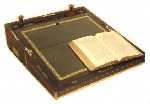 |
|
|
By the second decade of the 19th century the strengthening devices such as brass bindings, now often in the form of brass edgings, were enhanced with decorative features. Extra stringing, circles, fleur-de-lis, intricate escutcheons, ornamental top plates. Instead of solid mahogany throughout, the boxes were made in plain mahogany for strength and stability and then veneered in figured mahogany, rosewood or kingwood. The veneers were carefully selected for their rich appearance. The surfaces were French polished which enhanced the beauty of the dark striations within such woods as kingwood and rosewood and the beautiful figure of mahogany and other woods. The writing surfaces were covered in velvet or leather and the interior was sometimes polished. The secret drawers were by this time more popular than the side drawer. Occasionally both were used, especially on larger boxes. Request current list of available writing boxes.
|
|
|
Triple and Captain's boxes from this period are very rare.
The first boxes to depart from the military look still retained their robust qualities. Gradually however the military features such as handles and thick brass edgings and corners gave way to more ornamental rather than strengthening use of brass. Dark rosewood or figured mahogany boxes were made with subtle brass stringing enhanced with circular small ornaments or curvilinear escutcheons. Other boxes were more ambitiously ornamented in the manner promoted by Thomas Hope with borders of floral swags. Occasionally a box was completely covered with inlays of leaves, flowers and even grotesques in flowing combinations. Dark woods and bright brass are certainly mutually enhancing and these high Regency boxes have an excellent 'period' look. Another decorative device, which was beginning to be used from about the second decade of the 19th century, was inlay in mother of pearl. This was very fine and usually consisted of stylized floral designs. Birds and the occasional animal, such as deer were sometimes incorporated within the design. White metal lines were used if stringing was required. Request current list of available writing boxes.
|
|

|
|
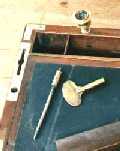 ENLARGE |
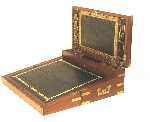 |
|
 ENLARGE |
|
|
Simpler boxes of rosewood with mother of pearl circles and metal stringing were beginning to appear by the 1820s. This style continued to be made for a few decades, the veneers becoming thinner as the century progressed. During the early part of the 19th century, vandyke and cube Tunbridge Ware, mahogany, yew, or fruitwood boxes with marquetry, stringing, crossbanding, or in combinations of woods were also made. These boxes are often unique, idiosyncratic and delightful with a character all of their own and very sought after by serious collectors. Characteristics of early 19th century writing boxes: 1. Thick veneers of mahogany, kingwood, rosewood, occasionally yew or fruitwoods on mahogany base.
As in the writing boxes, inlaid brass, mother of pearl and marquetry were used for decoration. In addition very fine examples of Chinnoiserie, Penwork and Tunbridge Ware slopes date from this period, although these are now few and far between. Another kind of writing slope, which made its appearance in England at about this time, was in the Boulle style, in tortoiseshell and brass. These were mostly imported from France. The shapes of these slopes are elaborate versions of the wooden slopes. The back part is higher and often curved. The interiors are of polished rosewood, or ebonized wood. The flaps are velvet covered. Papier Mâchè slopes had only one flap opening downwards allowing for the continuity and integrity of their fine decoration. Few rare and very beautiful Anglo Indian boxes in both shapes date from this period. he steel pen nib, which was first patented by Gillott in 1831, made the use of quills or rigid metal pens unnecessary. Writing became simpler. The Penny Post in 1840 enabled the sender to pay for letters and as a result letters quadrupled in the following decade. They were followed by postcards, Christmas cards, Greeting cards and Valentines. Request current list of available writing boxes.
|
|
|
WRITING BOXES AND SLOPES 1830 to 1900
Easily portable writing boxes became obligatory for more people as more people transacted business, traveled or wrote letters from home.
|
|
 |
A good example of a mid century writing box veneered in well figured walnut and edged in brass. The interior has the characteristic two flaps and secret drawers. |
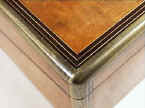 |
Detail: showing the brass corner, black edging with further inlaid lines, and slightly faded beautifully patinated surface of a Burr Walnut Writing Box Edged in Brass, Circa 1860. |
By the later part of the century the basic box was sometimes made of pine and veneered with very thin veneers. The brass became very thin or replaced with geometric inlays, which were produced using mechanical processes. These boxes are still very attractive but much lighter than their predecessors are. |
|
|
Tunbridge Ware inlays on writing slopes were now of
the mosaic pictorial type. Papier Mâchè decoration invariably
incorporated mother of pearl and abalone shell.
Wooden slopes in the earlier decorative styles disappeared but a new style developed out of the Gothic Revival. These were sloping boxes very much in the shape of the earlier ones. They were well made in mahogany, veneered in thick coromandel or burr walnut. They were decorated with overlays of perforated or engraved brass and sometimes with jasper medallions. Occasionally they formed part of a desk set with the back part higher and more rounded, or even in the form of a domed envelope/card box. These epitomize the ostentatious taste of the Victorian entrepreneur. They combine impeccable workmanship with glamour. Simpler burr walnut or coromandel slopes were also made. These relied for their appeal on the beauty of the grain of the wood or fine brass/mother of pearl decoration. The surviving examples are of very high quality. Request current list of available writing boxes.
|
|
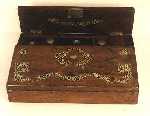 |
A rosewood writing slope of c1835 with fine mother of pearl inlay. The upper flap covers compartments for pens and inkwells. |
ANGLO INDIAN
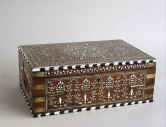 |
|
Very fine examples of Anglo Indian boxes date from this period. Sometimes combined with sewing boxes. These too are very rare.
Galleries of Antique Boxes
News | Buying | Contact us | The Schiffer Book | Advanced Search | Request current list of available writing boxes.
|
We maintain the website primarily as an information source. If you would like to be advised on the current availability of writing boxes and slopes please write telling us what you like | Request current list of available writing boxes The Schiffer book for collectors Antique Boxes, Tea Caddies and Society 1700-1880. by Antigone Clarke and Joseph O'Kelly is now in print and can be ordered from the links www.hygra.com/book |
© 1999/2015 Antigone Clarke and Joseph O'Kelly